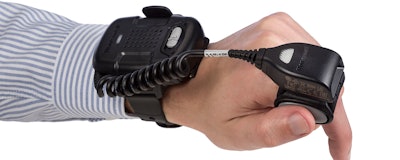
 Bruce Stubbs
Bruce StubbsAs smartwatches, fitness trackers and other wearable technologies become more common in our daily lives, distribution center workers are beginning to expect the same type of seamless usability and performance from the technology they use on the job.
Just as we no longer need to hold a device in our hand to receive a call, track steps or monitor social media, distribution center employees are looking for ways to free up their hands to be more productive and efficient in their daily tasks. And with companies losing on average more than $400,000 every year on picking errors, business owners are interested in new “connected worker” solutions that help improve efficiency and accuracy.
Today, many distribution centers are still using handheld scanners, paper-based picking methods and mobile computers to move and track goods as they make their way from one location to another. Early iterations of handheld scanners had wires, which at the time were an improvement, but restricted motion and became a nuisance when the wires got in the way. The industry has since moved to wireless, handheld scanners, which eliminate that problem, but still don’t enable workers to work “hands-free”. Also, the use of paper-based, or even mobile-based, picking methods requires the use of one’s hands, as well.
But things are now changing in distribution centers. From software that offers workers voice-based prompts to wearable barcode scanners connected via wireless communication standards like Bluetooth, new technologies that help free up workers’ hands and connect them to data more fluidly are helping to move the industry toward the next era of efficiency in data acquisition and order fulfillment.
For example, the industry has seen an increase in the adoption of voice-based solutions that instruct distribution center workers through their picking methods in real-time, and enable them to input data verbally, eliminating the need for physical picking lists or labels that must be carried around and updated manually. In fact, in a 2015 survey conducted by Honeywell and YouGov, 87 percent of U.S. respondents said they anticipate transitioning to voice solutions by 2020.
However, this does not completely address the issue, as data capture via printed barcodes is also a necessity in many of these environments. For that, wearable barcode scanners have been introduced as a means to enable workers to do more with their hands while still being able to easily scan a barcode as they move through the steps in a distribution center process. Together, voice-based guidance solutions and wearable barcode scanners create a completely hands-free environment that provides major advantages for businesses looking to improve worker comfort and stamina, along with overall accuracy, productivity and efficiency.
Moreover, interest in smart glasses has grown in recent years, but this technology is still in its infancy. Many companies are starting to bring different variations to market for industrial purposes, and some have started piloting programs to test the potential benefits this technology might bring to distribution centers. As we see more mainstream adoption of augmented reality devices in the consumer world, it’s expected that more beneficial use cases for the industrial sector will begin to emerge.
In the meantime, early adopters should begin to make the transition toward wearable technology through the adoption of hands-free scanners and voice-directed software that immediately eliminate the need for handheld devices and paper picking methods.
As the expectations of similar easy-to-use, consumer-like technology experiences in industrial settings grow among manufacturing and distribution center workers, many organizations want flexibility in their mobile computing options. Having a range of device options poses significant advantages for supply chain firms, which is why it’s now essential for wearable barcode scanners to be Bluetooth-enabled and compatible with range of host-computing devices, including a smartphone, vehicle mounted computer, or other device.
Through Bluetooth connectivity, a wearable barcode scanner resembling a ‘ring’ is not limited to one particular host device. It can be connected to a PC for stationary scanning tasks, or a variety of mobile devices for tasks that require movement throughout the facility. We expect to see this become an even more important capability as different types of connected devices continue to infiltrate the distribution center and interoperability becomes crucial to the process flow.
In addition to interoperability and seamless wireless connectivity, ergonomics are very important when it comes to wearable devices. Wearable barcode scanners must be small enough to fit comfortably on the user’s finger without getting in the way or moving around, while the rest of the unit rests sturdily on the user’s wrist. In a distribution center environment, wearable devices that are not designed with the appropriate durability and ergonomics in mind might actually make tasks more cumbersome.
Today, improved efficiency in picking applications is the main driver of wearable scanner adoption. As these benefits continue to be realized, expect to see widespread adoption of wearable devices throughout the distribution center and elsewhere. Anywhere a handheld scanner is used — from receiving to sorting to packing — companies will be able to increase productivity by replacing it with a wearable device.
Bruce Stubbs is Director of Supply Chain Marketing at Honeywell Safety & Productivity Solutions.























